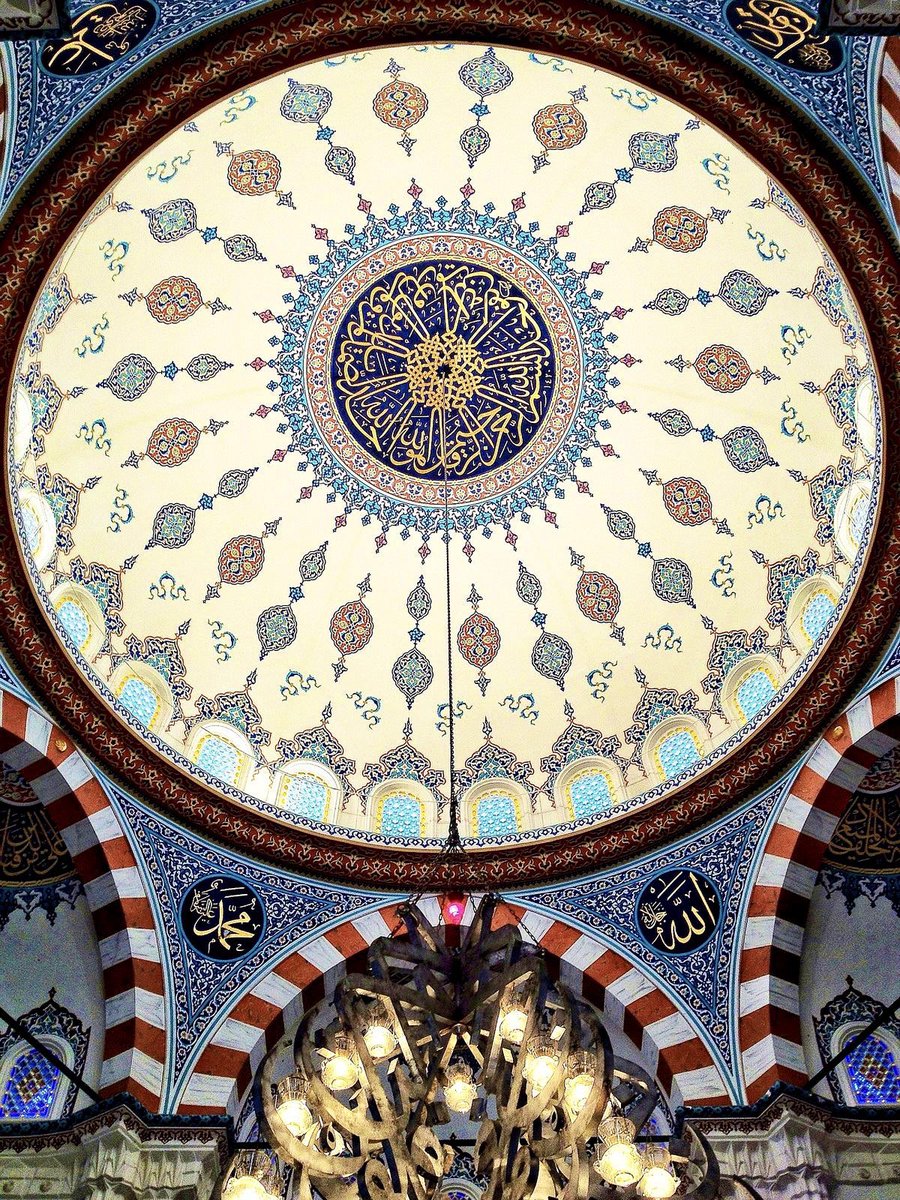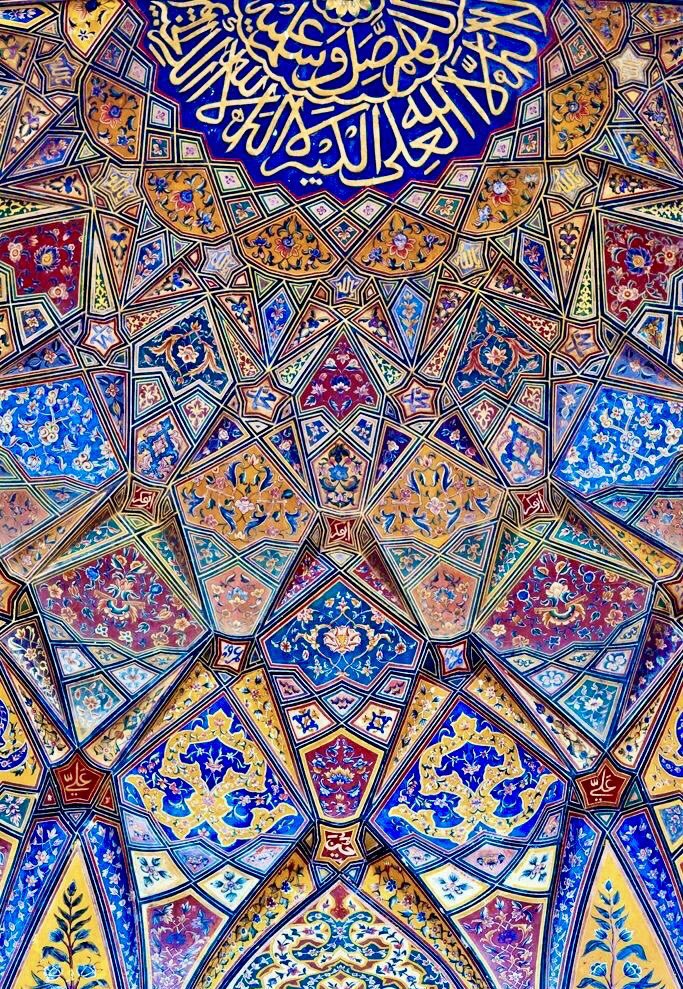During the last 10 nights of Ramadan, many Muslims spend more time in Mosques in contemplation & prayer.
Mosque ceilings are designed to reflect the magnificence of the universe.
For Ramadan, here are spectacular details of 24 Mosque ceilings from around the world…
A thread…
Mosque ceilings are designed to reflect the magnificence of the universe.
For Ramadan, here are spectacular details of 24 Mosque ceilings from around the world…
A thread…

1/ The ceiling of Shah Mosque in Tehran, Iran
Built to the order of Fath-Ali Shah Qajar of Persia during the Qajar period, as one of several such symbols of legitimacy for the new dynasty. Construction started in 1810 & completed in 1825 #Ramadan
Built to the order of Fath-Ali Shah Qajar of Persia during the Qajar period, as one of several such symbols of legitimacy for the new dynasty. Construction started in 1810 & completed in 1825 #Ramadan

2/ The ceiling of Sheikh Lotfollah Mosque, Naqsh-i Jahan Square, Esfahan, Iran
Construction of the mosque started in 1603 & finished in 1619. Built by the chief architect Mohammadreza Isfahani, during the reign of Shah Abbas I of Persia. Beautiful interior dome details #Ramadan
Construction of the mosque started in 1603 & finished in 1619. Built by the chief architect Mohammadreza Isfahani, during the reign of Shah Abbas I of Persia. Beautiful interior dome details #Ramadan

3/ The ceiling of Al-Askari Mosque, Samarra, Salah al-Din Governorate, Northern Iraq
Built in 944 it is a Shia Muslim mosque & mausoleum in the Iraqi city of Samarra 125 km from Baghdad. It is one of the most important Shia shrines in the world & is decorated in tiles #Ramadan
Built in 944 it is a Shia Muslim mosque & mausoleum in the Iraqi city of Samarra 125 km from Baghdad. It is one of the most important Shia shrines in the world & is decorated in tiles #Ramadan

4/ The ceiling of Jami Mosque, Andijan, Uzbekistan
Construction of the madrasah began in 1883 & lasted 7 years. It has fretwork of wooden columns supporting a ceiling decorated with bright patterns made of a combination of geometrical ornaments & vegetal elements #Ramadan
Construction of the madrasah began in 1883 & lasted 7 years. It has fretwork of wooden columns supporting a ceiling decorated with bright patterns made of a combination of geometrical ornaments & vegetal elements #Ramadan

6/ The ceiling of Jameh Mosque, Yazd, Iran
The 14th-century mosque is still in use today. It was first built under Ala'oddoleh Garshasb of the Al-e Bouyeh dynasty. It was largely rebuilt between 1324 & 1365. The ceiling was built like a porch in the heart of the desert #Ramadan
The 14th-century mosque is still in use today. It was first built under Ala'oddoleh Garshasb of the Al-e Bouyeh dynasty. It was largely rebuilt between 1324 & 1365. The ceiling was built like a porch in the heart of the desert #Ramadan

7/ The ceiling of Tokyo Mosque, (東京ジャーミイ), Ōyama-chō district of Shibuya ward in Tokyo, Japan
The largest mosque in Japan. Originally built in 1938 the current building was completed in 2000. It was designed by Hilmi Senalp in Ottoman architecture style #Ramadan
The largest mosque in Japan. Originally built in 1938 the current building was completed in 2000. It was designed by Hilmi Senalp in Ottoman architecture style #Ramadan

8/ The ceiling of Bolo Haouz Mosque, Bukhara, Uzbekistan
Built in 1712, on the opposite side of the citadel of Ark in Registan district. Thin columns made of painted wood were added to the frontal part of the iwan (entrance) in 1917 #Ramadan
Built in 1712, on the opposite side of the citadel of Ark in Registan district. Thin columns made of painted wood were added to the frontal part of the iwan (entrance) in 1917 #Ramadan

9/ The ceiling of Al-Aqsa Mosque, Jerusalem, Palestine
In the Old City of Jerusalem, the 3rd holiest site in Islam. It was built on top of the Temple Mount, known as the Al Aqsa Compound or Haram esh-Sharif in Islam, several decades after Prophet Muhammad's (PBUH) death #Ramadan
In the Old City of Jerusalem, the 3rd holiest site in Islam. It was built on top of the Temple Mount, known as the Al Aqsa Compound or Haram esh-Sharif in Islam, several decades after Prophet Muhammad's (PBUH) death #Ramadan

10/ The ceiling of Nasir Al Mulk, Shiraz, Iran
Built during the Qajar dynasty in 1876 by the order of Mirza Hassan Ali Nasir-ol-Mulk, and was completed in 1888. The designers were Mohammad Hasan-e-Memār, Mohammad Hosseini Shirazi, and Mohammad Rezā Kāshi-Sāz-e-Širāzi #Ramadan
Built during the Qajar dynasty in 1876 by the order of Mirza Hassan Ali Nasir-ol-Mulk, and was completed in 1888. The designers were Mohammad Hasan-e-Memār, Mohammad Hosseini Shirazi, and Mohammad Rezā Kāshi-Sāz-e-Širāzi #Ramadan

11/ The ceiling of Wazir Khan Mosque, Lahore, Pakistan
Built in 1641 it is considered the most ornately decorated Mughal-era mosque renowned for its intricate faience tile work known as kashi-kari & its interior surfaces that are embellished with Mughal-era frescoes #Ramadan
Built in 1641 it is considered the most ornately decorated Mughal-era mosque renowned for its intricate faience tile work known as kashi-kari & its interior surfaces that are embellished with Mughal-era frescoes #Ramadan

12/ The ceiling of Hafez Tomb, Shiraz, Iran
Built in 1773 in memory of the celebrated Persian poet Hafez. The open pavilion structures are situated in the Musalla Gardens on the north bank of a seasonal river and house the marble tomb of Hafez #Ramadan
Built in 1773 in memory of the celebrated Persian poet Hafez. The open pavilion structures are situated in the Musalla Gardens on the north bank of a seasonal river and house the marble tomb of Hafez #Ramadan

13’ The ceiling of Badshahi Mosque, Pakistan
Built by Mughal emperor Aurangzeb between 1671 & 1673 it was the largest mosque in the world from 1673 to 1986. A great example of Mughal architecture with an exterior decorated with carved red sandstone & marble inlay #Ramadan
Built by Mughal emperor Aurangzeb between 1671 & 1673 it was the largest mosque in the world from 1673 to 1986. A great example of Mughal architecture with an exterior decorated with carved red sandstone & marble inlay #Ramadan

14/ The ceiling of a Mosque, near Erbil Citadel, Iraq
Multicoloured ceiling with verses written from the Qur’an #Ramadan
Multicoloured ceiling with verses written from the Qur’an #Ramadan

15/ The ceiling of Sheikh Zayed Grand Mosque, Abu Dhabi, United Arab Emirates
The largest mosque in the country, it was constructed between 1994 & 2007. The project was launched by the late president of the United Arab Emirates (UAE), Sheikh Zayed bin Sultan Al Nahyan #Ramadan
The largest mosque in the country, it was constructed between 1994 & 2007. The project was launched by the late president of the United Arab Emirates (UAE), Sheikh Zayed bin Sultan Al Nahyan #Ramadan

16/ The ceiling of Tila Kari, Samarkand, Uzbekistan
Commissioned a decade after the adjacent Shir Dar madrasa (1619-1636). The last, largest and most embellished structure of the famed Registan Square. It's name means ''gold-covered' #Ramadan
Commissioned a decade after the adjacent Shir Dar madrasa (1619-1636). The last, largest and most embellished structure of the famed Registan Square. It's name means ''gold-covered' #Ramadan

17/ The ceiling of Shahi Mosque Chiniot, Pakistan
A historic 17th century mosque located in Chiniot, Punjab. It was built under supervision of Mughal Grand Vizier Saadullah Khan #Ramadan
A historic 17th century mosque located in Chiniot, Punjab. It was built under supervision of Mughal Grand Vizier Saadullah Khan #Ramadan

18/ The ceiling of Nur Astana Mosque, Kazakhstan
The third largest mosque in Central Asia. The 40-meter height symbolizes the age of Prophet Muhammad (PBUH) when he received the revelations, and the height of the minarets are 63 meters, the age when he died #Ramadan
The third largest mosque in Central Asia. The 40-meter height symbolizes the age of Prophet Muhammad (PBUH) when he received the revelations, and the height of the minarets are 63 meters, the age when he died #Ramadan

19/ The ceiling of Seyed Mosque, Isfahan, Iran
The biggest & the most famous mosque from the Qajar era. It was founded by Seyyed Mohammad Bagher Shafti, one of the most famous clergymen in Isfahan in the middle of the 19th century #Ramadan
The biggest & the most famous mosque from the Qajar era. It was founded by Seyyed Mohammad Bagher Shafti, one of the most famous clergymen in Isfahan in the middle of the 19th century #Ramadan

20/ The ceiling of Putra Mosque, Putrajaya, Malaysia
Building began in 1997 & completed in 1999. The pink-domed Mosque is constructed with rose-tinted granite & includes a prayer hall, courtyard & learning facilities. The mosque can accommodate 15,000 worshippers #Ramadan
Building began in 1997 & completed in 1999. The pink-domed Mosque is constructed with rose-tinted granite & includes a prayer hall, courtyard & learning facilities. The mosque can accommodate 15,000 worshippers #Ramadan

21/ The ceiling of Goharshad Mosque, Mashhad, Iran
A grand congregational mosque built during the Timurid period in Mashhad, Razavi Khorasan Province, Iran, which now serves as one of the prayer halls within the Imam Reza shrine complex #Ramadan
A grand congregational mosque built during the Timurid period in Mashhad, Razavi Khorasan Province, Iran, which now serves as one of the prayer halls within the Imam Reza shrine complex #Ramadan

22/ The ceiling of Al-Ashrafiya Mosque, Taiz, Yemen
Considered to be one of the most important centers in the Islamic history of Yemen. It was supposedly built in 2 stages: by Sultan Al-Ashraf Umar II (1295-6) by Sultan Al-Ashraf Isma'il I (1377-1400) & opened in 1382 #Ramadan
Considered to be one of the most important centers in the Islamic history of Yemen. It was supposedly built in 2 stages: by Sultan Al-Ashraf Umar II (1295-6) by Sultan Al-Ashraf Isma'il I (1377-1400) & opened in 1382 #Ramadan

23/ The ceiling of Sayyidah Ruqayyah Masjid, Damascus, Syria
The mosque contains the grave of Sukaynah (née Ruqayyah), the young daughter of Al-Husayn ibn ‘Alī. It was built around the mausoleum in 1985 and exhibits the modern style of Iranian architecture #Ramadan
The mosque contains the grave of Sukaynah (née Ruqayyah), the young daughter of Al-Husayn ibn ‘Alī. It was built around the mausoleum in 1985 and exhibits the modern style of Iranian architecture #Ramadan

24/ The ceiling of Central Mosque of St. Petersburg, Russia
When opened in 1913 it was the largest mosque in Europe outside Turkey, its minarets 49 meters in height & the dome is 39 meters high. It can accommodate up to 5000 worshippers & is renowned for its blue tiles #Ramadan
When opened in 1913 it was the largest mosque in Europe outside Turkey, its minarets 49 meters in height & the dome is 39 meters high. It can accommodate up to 5000 worshippers & is renowned for its blue tiles #Ramadan

Explore the beauty, magnificence and wonder of Mosque ceilings from across the world:
baytalfann.com/post/spectacul…
baytalfann.com/post/spectacul…
• • •
Missing some Tweet in this thread? You can try to
force a refresh























